Cover image of Black Crake by Anthony Paton – Kruger National Park, Limpopo – BirdPix No. 41149
Crakes belong to the Family: RALLIDAE. This family also includes Rails, Flufftails, Gallinules, Moorhens and Coots etc. Their physiology is diverse, but most have laterally compressed bodies, short tails, short rounded wings and well developed legs and feet. The bill structure is variable. Most birds in this family inhabit wetlands or forest undergrowth and are usually vocal and highly secretive.
Identification
The Black Crake is a smallish and striking, all-black water bird.
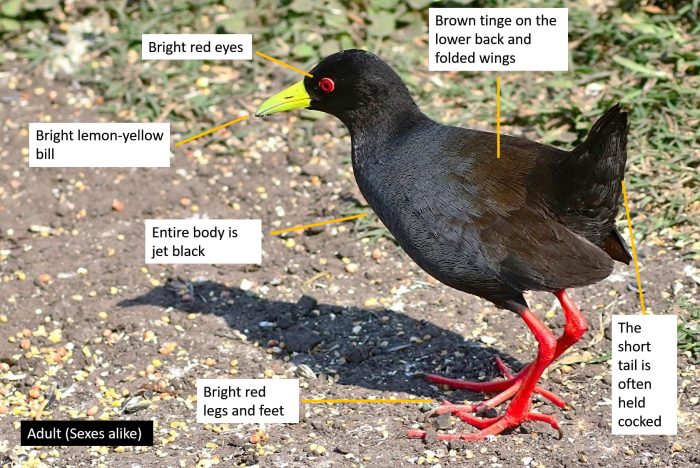
Port Edward, KwaZulu-Natal
Photo by Lia Steen
The entire body is jet-black (sometimes with a brownish hue on the folded wings and lower back). The bill is bright greenish-yellow and the eyes are vivid red. The well developed legs and feet are bright red in breeding condition or dull red during the non-breeding season.
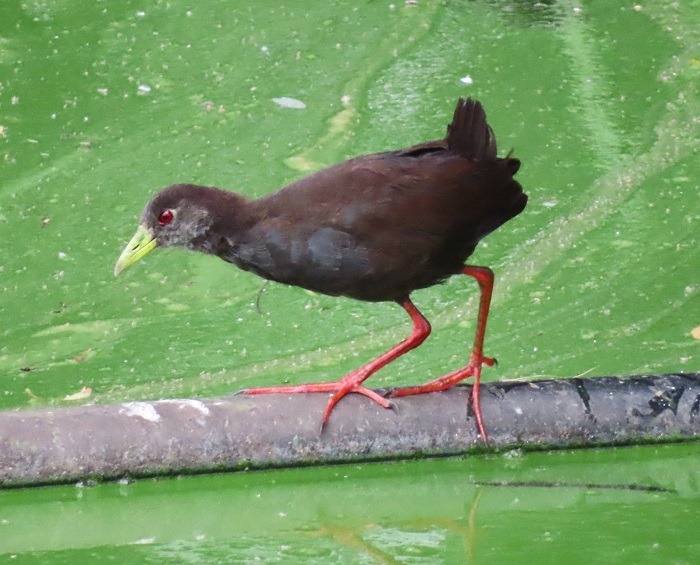
K’Shane Estate, North West
Photo by Felicity Ellmore
Juveniles have dark olive-brown upper parts, dark grey under parts and a whitish throat. The bill is dull greenish-yellow and the red legs are duller than those of the adults.
Adult Black Crakes are unmistakable and unlike any other African bird.
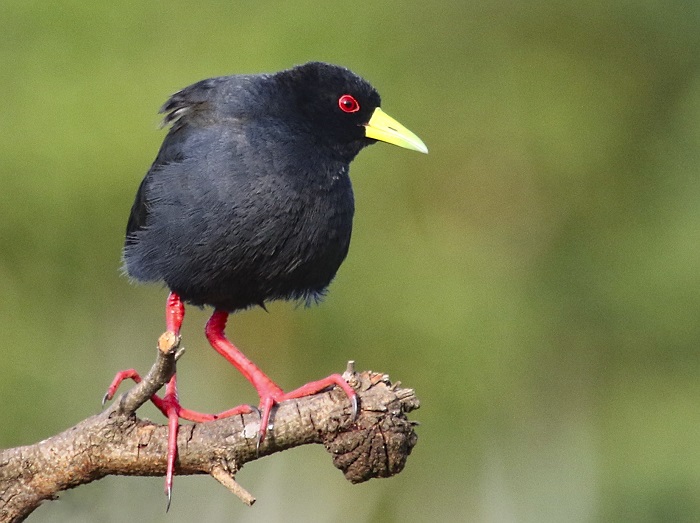
Port Edward, KwaZulu-Natal
Photo by Lia Steen
Status and Distribution
The Black Crake is generally a common resident with some local movements during dry periods. The Black Crake is found throughout sub-Saharan Africa, except for arid regions. It is the commonest and most widespread crake species in Africa.
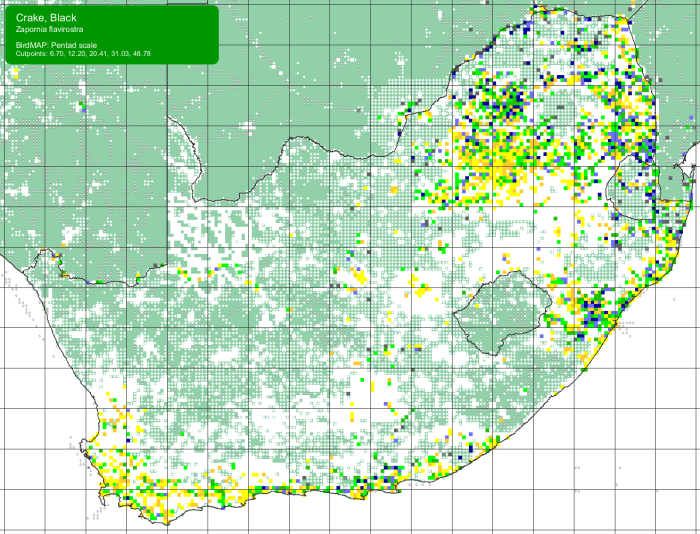
In southern Africa, the Black Crake occurs in northern Namibia and Botswana, most of Zimbabwe and Mozambique, northern and eastern South Africa and along the eastern littoral to the Western Cape. There are scattered records elsewhere including the semi-arid and arid parts of Namibia and the Karoo where it may be very localised.
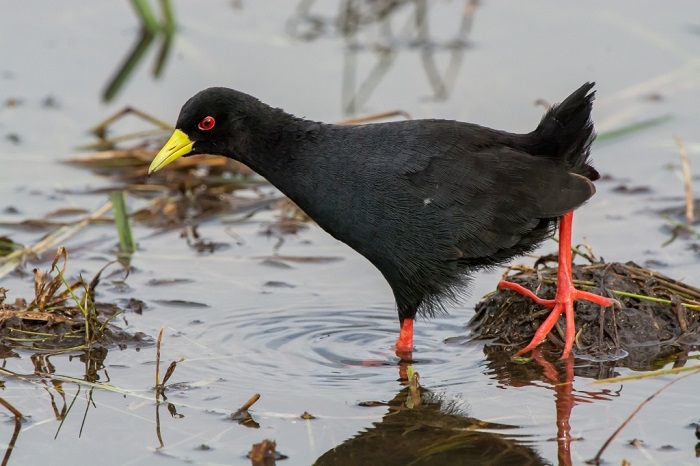
Garden Route National Park, Western Cape
Photo by Jean Hirons
The Black Crake is not threatened. There is no evidence of any range contractions but it has likely been affected by the continual loss of wetland habitats in some areas. Conversely, the Black Crake is often common at a variety of man-made water bodies.
Habitat
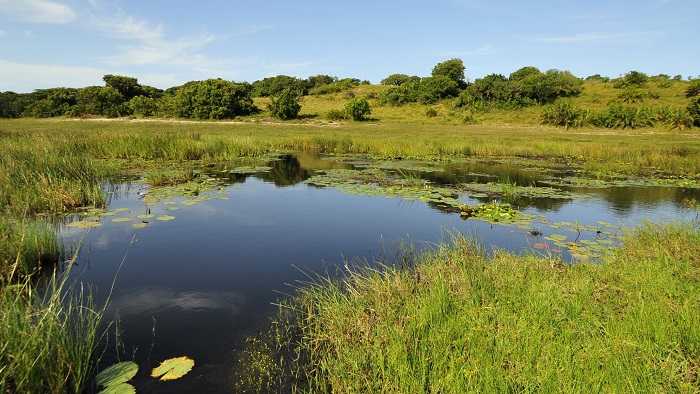
Kosi Bay, iSimangaliso Wetland Park, KwaZulu-Natal
Photo by Ryan Tippett
The Black Crake occupies a wide range of fresh and brackish wetland habitats, including marshes, pans, dams, ornamental ponds, rivers, streams, estuaries and sewage ponds. It frequents still and flowing water, and both seasonal and perennial wetlands. The Black Crake prefers dense, tangled vegetation such as reedbeds, sedges, Papyrus (Cyperus papyrus) stands and rank grass. Also inhabits swampy thickets, bushes and other thick growth near water.
Behaviour
The Black Crake is largely sedentary but may be locally nomadic in the drier parts of its range in response to rainfall and water levels. The Black Crake is usually solitary but can also be found in pairs or in small family groups.
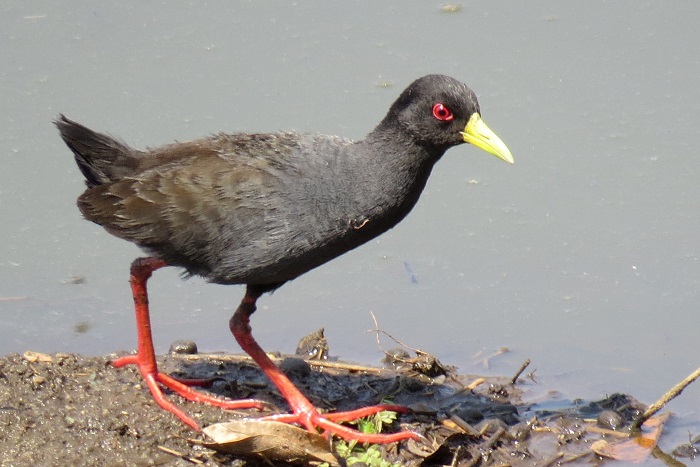
Mapungubwe National Park, Limpopo
Photo by Terry Terblanche
The Black Crake is most active by day and sometimes also on moonlit nights, becoming very active after rain. The main activity period is during the morning and late afternoon, but forages throughout the day in winter. The Black Crake flies reluctantly but strongly when disturbed. They will usually fly back into cover, but prefer to run away through vegetation and over water plants. The Black Crake swims well, even under water, but usually only when threatened. Adults are known to build platforms in vegetation for resting or preening and pairs, helpers and young frequently engage in allopreening.
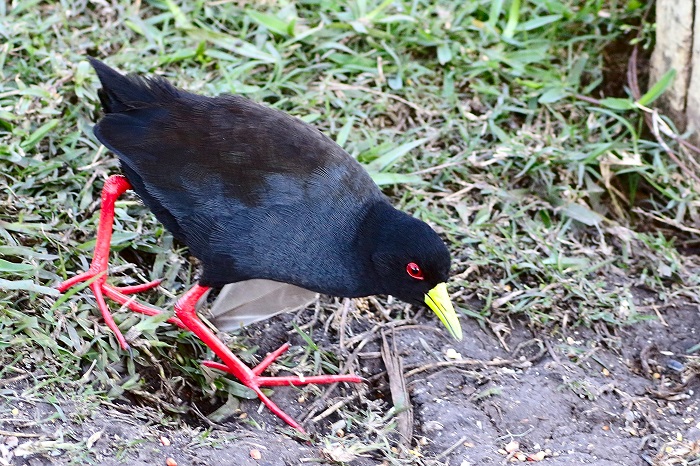
Port Edward, KwaZulu-Natal
Photo by Lia Steen
The Black Crake is less shy than most others in the family, and often forages in the open, especially during the winter months when breeding is over. They can become quite tame and confiding, and are sometimes regular visitors at picnic spots and garden bird feeders when these adjoin wetland habitats. It is regularly seen walking across floating plants or in areas of short grass and along muddy shorelines. Black Crakes often clamber into bushes and low trees, especially over water. Also climbs high up above the water in dense reedbeds or Papyrus stands.
The Black Crake is omnivorous and has a varied diet that includes earthworms, molluscs, crustaceans, insects and their larvae, frogs, tadpoles, small fish, bird eggs and the nestlings of weavers and other bird species. The Black Crake is even known to kill and eat small birds caught in mist nets. Also consumes the seeds, stems and leaves of various water plants, including duckweed (Lemna sp) and the seeds of water lilies (Nymphaea spp). The Black Crake frequently scavenges when the opportunity arises, feeding on dead crabs, frogs, fish, insects and small birds etc.
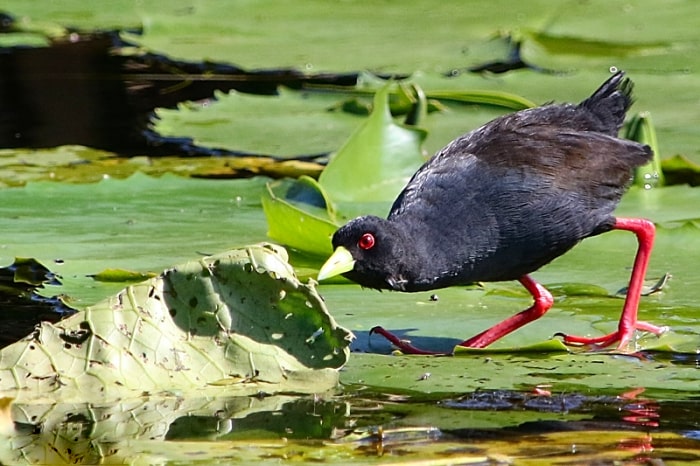
Port Edward, KwaZulu-Natal
Photo by Lia Steen
The Black Crake forages by pecking and probing food off of water plants, muddy substrate and from the water surface. They will also climb reeds to snatch insects. Catches small fish, tadpoles and aquatic insects by rapidly immersing the head and neck into shallow water. Meticulously searches under debris and fallen plants and pulls down the leaves of water plants to search for prey. They will also forage in cultivated areas, gardens and dry or burned ground near water.
Additionally, Black Crakes have been observed perching on the backs of Warthogs (Phacochoerus aethiopicus) and Hippopotamus (Hippopotamus amphibius), most likely in the hope of gleaning ectoparasites. The Black Crake is also known to associate with foraging animals near the waters edge such as warthogs in order to catch disturbed prey.
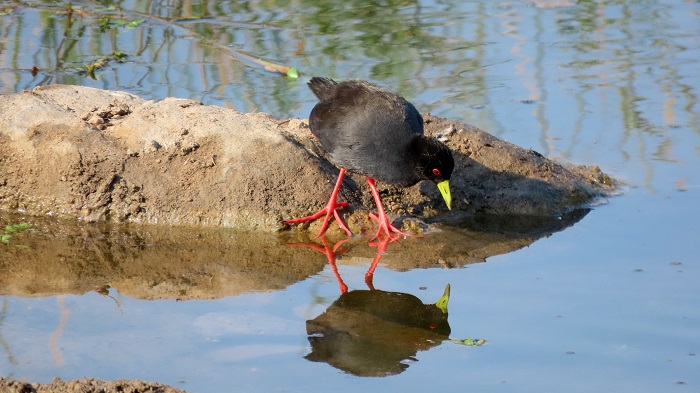
Kruger National Park, Limpopo
Photo by Johan Van Rooyen
The Black Crake is a monogamous, cooperative breeder. They are strongly territorial and males set up territories at the start of the breeding season. Territory establishment is accompanied by increased vocalisations. They are aggressive when marking out and defending territories and readily chase off conspecifics and other species. Territories are not defended post breeding.
The Black Crake is multiple-brooded, producing more than one clutch during the breeding season. The Offspring of the previous brood often remain as ‘helpers’ during subsequent breeding attempts. The helpers assist with incubation and in rearing the young of the following brood. They often remain with the family group until the end of the breeding season. The breeding season runs from October to April in southern Africa. Under suitable conditions, breeding may occur throughout the year, but in most regions there are seasonal peaks. In southern Africa these peaks occur during November and again between January and March.
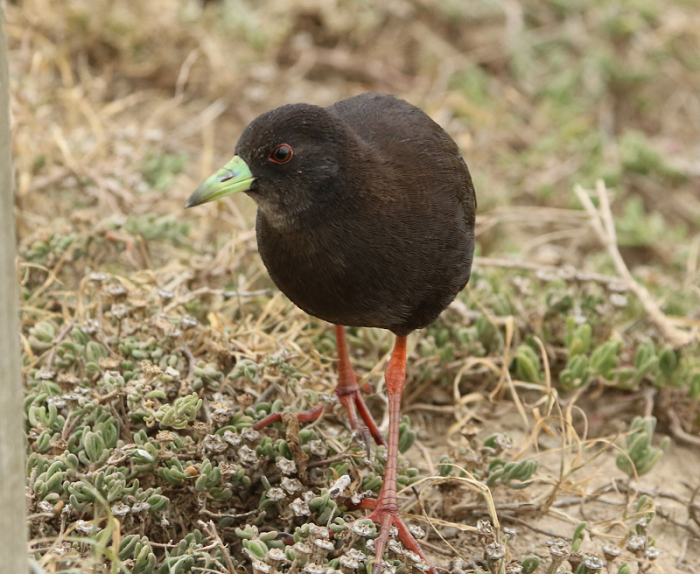
Gouritspoort, Western Cape
Photo by Johan van Aarde
The nest is a deep cup made from the leaf-blades and stems of aquatic plants. It is usually well hidden among vegetation and bits of plant stems and other vegetation are sometimes pulled over the nest to form a canopy. The nest is usually placed over water, anywhere from just above the water level to 3 meters up. The nest may occasionally be built on firm ground near water or floating, attached to emergent vegetation.
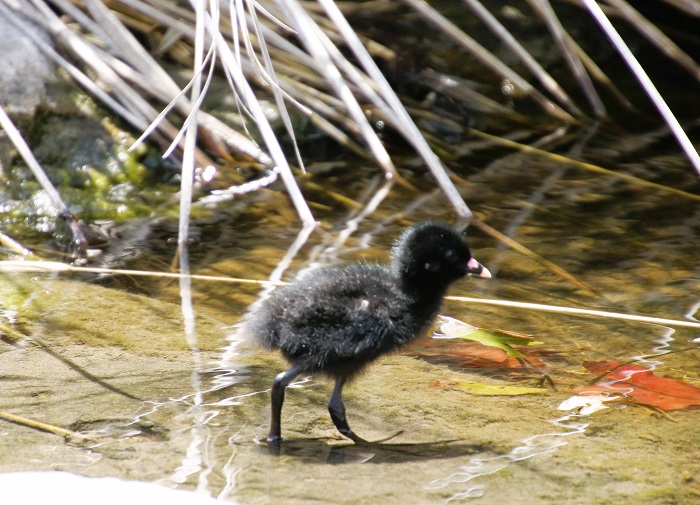
Kruger National Park, Mpumalanga
Photo by Ruth Robinson
Clutch size ranges from 2 to 6 eggs, laid at 1 day intervals. The incubation period lasts for 13 to 19 days and is done by both sexes, sometimes with helpers from the previous brood. Incubation changeovers are often accompanied by raucous duetting. The eggs hatch asynchronously. The newly hatched young have pink and black bills and are covered in black down. Chicks are precocial and are able to move away from the nest within 1 day of hatching. They are fully fledged at 5 weeks old.
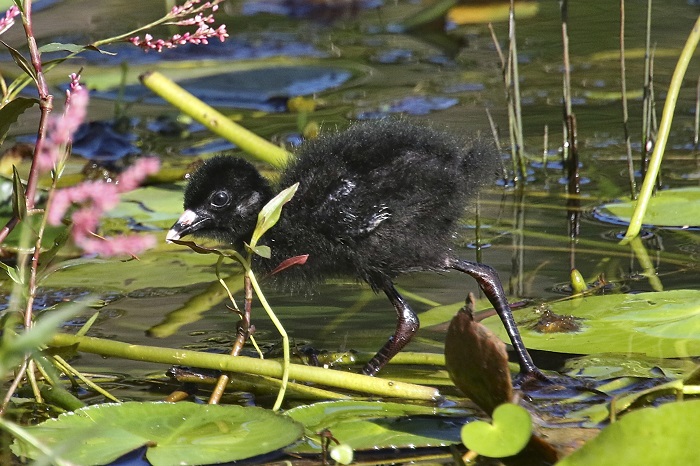
Port Edward, KwaZulu-Natal
Photo by Lia Steen
Further Resources
Species text from the first Southern African Bird Atlas Project (SABAP1), 1997.
The use of photographs by Anthony Paton, Felicity Ellmore, Jean Hirons, Johan van Aarde, Johan Van Rooyen, Lia Steen, Ruth Robinson, Terry Terblanche, Tony Archer is acknowledged.
Virtual Museum (BirdPix > Search VM > By Scientific or Common Name).
Other common names: Swartriethaan (Afrikaans); umJekejeke ,umJengejenge (Zulu); Hukunambu (Tswana); Zwart Poseleinhoen (Dutch); Marouette à bec jaune, Râle à bec jaune (French); Mohrenralle, Negerralle (German); Franga-d’água-preta (Portuguese)
A list of bird species in this format is available here.
Recommended citation format: Tippett RM 2024. Black Crake Amaurornis flavirostra. Biodiversity and Development Institute. Available online at https://thebdi.org/2024/08/20/black-crake-amaurornis-flavirostra/
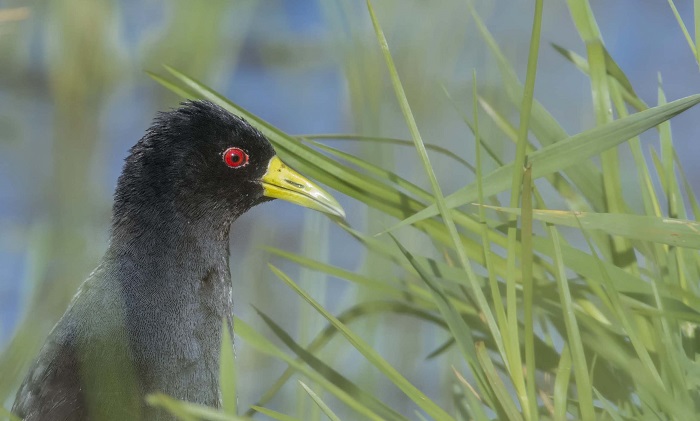
Koekemoer Spruit, North West
Photo by Tony Archer

